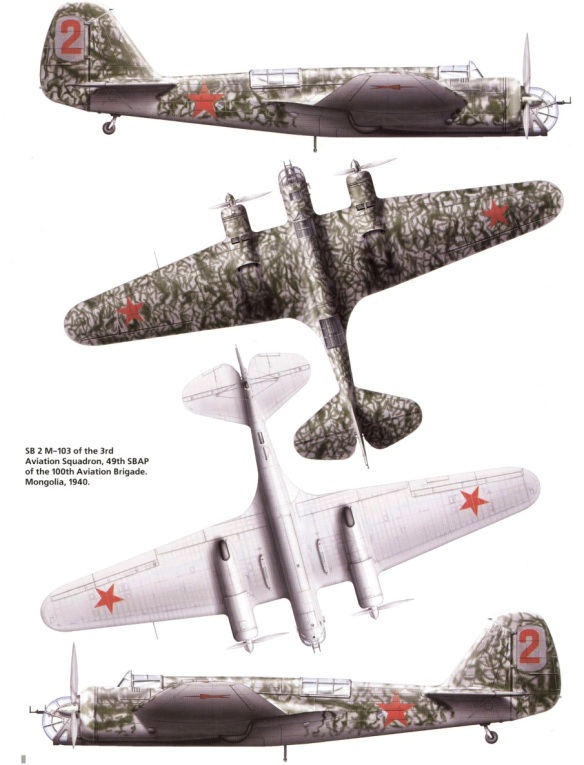Familiarly called the Katyusha, the Tupolev SB was first flown on October 7, 1933. Intended as a high-speed bomber, it was at the time one of the Tupolev organization’s most advanced designs, based on a heavy fighter airframe rather than a bomber. Construction was all metal and, in service during the Spanish civil war, its 255-mile-per-hour speed outflew many enemy fighters-until the appearance of the German Bf- 109 fighter. A total of 6,656 SBs were built up to 1940, and some remained in service until 1943, despite heavy losses to the Bf-109s.
Fast-flying SBs were among the world’s best bombers when they appeared in 1936. They enjoyed a distinguished career in Spain, Mongolia, and Finland before suffering heavy losses in World War II.
In 1933 the Soviet government announced specifications for an entirely new light bomber, one so fast that it could operate without escort fighters. The Tupolev design bureau finessed the problem with great skill, and in 1934 it built two prototypes with radial and in-line engines respectively. The new SB was Russia’s first stressed-skin aircraft, a midwing, all-metal monoplane bomber. It was modern in every respect to Western contemporaries and possessed such advanced features as retractable landing gear and flush-riveting. A crew of four was comfortably housed, and the plane flew faster than any fighter or bomber then in service, including the highly touted Bristol Blenheim. In 1936 the in-line engine prototype entered production as the SB, and nearly 7,000 were produced. These modern, capable craft formed the bulk of Soviet tactical aviation over the next five years and played a major role in modernizing and revitalizing the Soviet bomber forces.
SBs were bloodied in the Spanish Civil War (1936-1939), where they proved impervious to slower Nationalist fighters. They also enjoyed similar success in Mongolia against the Japanese and were exported to China in quantity. Several new versions were also introduced with more powerful engines, but this robust design was growing obsolete in light of developments elsewhere. SBs again fought well against Finland during 1939-1940, but when Germany invaded Russia the following year they lost their speed advantage. Being somewhat flammable, scores were quickly dispatched by formidable Messerschmitt Bf 109 and Bf 110 fighters. But they were abundantly available, and so the Soviets had little recourse but to continually employ them. They did so in a wide variety of roles, including that of night intruder and torpedo-bomber. By the time SBs withdrew in 1943, they had sustained the heaviest losses of any Russian aircraft in World War II.
The SB was driven by twin 850-horsepower M100 V-12 piston engines to a top speed of 255 miles per hour and a service ceiling of 27,885 feet. Its range was a modest 746 miles. Wingspan was 66 feet 8 ½ inches, and defensive armament consisted of two 0.3-inch machine guns in a nose turret, one in a dorsal turret, and one in the ventral position. Bomb capacity was 2,205 pounds, and the plane was crewed by three.
Specifications (SB 2M-103)
General characteristics
Crew: 3
Length: 12.57 m (41 ft 2¾ in)
Wingspan: 20.33 m (66 ft 8 in)
Height: 3.60 m (11 ft 9¾ in)
Wing area: 56.7 m² (610.3 ft2)
Empty weight: 4,768 kg (10,512 lb)
Loaded weight: 6,308 kg (14,065 lb)
Max. takeoff weight: 7,880 kg (17,370 lb)
Powerplant: 2 × Klimov M-103 liquid-cooled V12 engine, 716 kW (960 hp) each
Performance
Maximum speed: 450 km/h (243 knots, 280 mph) at 4,100 m (13,450 ft)
Range: 2,300 km (1,243 nmi, 1,429 mi)
Service ceiling: 9,300 m (30,510 ft)
Climb to 1,000 m (3,280 ft): 1.8 min
Climb to 9,000 m (29,500 ft): 32 min
Armament
Guns: 4 × 7.62 mm ShKAS machine guns (two in nose, one in dorsal and one in ventral position)
Bombs: 6 × 100 kg (220 lb) or six 50 kg (110 lb) bombs in bomb-bay, 2 × 250 kg (550 lb) bombs on wing racks
Note:
It’s “SB”, folks. not “SB-2”
Index SB of Arkhangelsky’s high-velocity bomber comes from plain meaning:
“Skorostnoi Bombardirovshik”.
skorostnOi = high velocity
bombardirOvshik = bomber
Actual index must be like below
SB 2RTs
SB 2IS
SB 2M-100
SB 2M-100A
SB 2M-103
etc.
the index reads “SB with TWO engines ”.
I don’t know why west took TWO as a part of plane’s name.
It is obviously NOT named like MiG-1, Il-2, Su-2, Ar-2 or Pe-2, because such nomination was introduced much later.
On the other hand, SB cannot be with ONE engine to use “SB-1” index.
On the third hand it is not SECOND bomber or SECOND design.
For those who is interested:
RTs is Rait Tsiklon, Wright Cyclone transliterated into cyrillic. it is licensed R-1820-F3, named M-25 in USSR.
IS is Ispano Syuiza, Hispano Suiza transliterated into cyrillic. it is also licensed production. engine development gave a row of V. Klimov’s engines M-100, M-103, M-105 (VK-105), VK-107.
